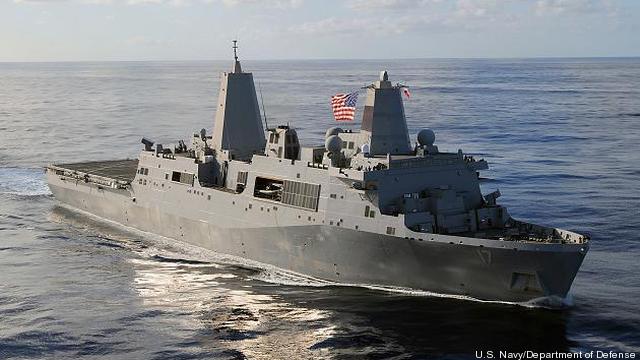
The amphibious ship USS San Antonio, LPD-17.
CAPITOL HILL: Sometimes $800 million is not enough.
Congress really, really wants the Navy to buy a 12th San Antonio-class amphibious warship. The Marine Corps really, really wants the ship, which would be designated LPD-28. And of course shipbuilder Huntington-Ingalls really, really wants the contract, which would help fill a multi-year gap in amphib construction.
But the Navy’s top acquisition official, Sean Stackley, made clear today the service dares not sign that contract until it’s confident that it will eventually get full funding to buy the ship, over $2 billion. Congress already voted $243 million “advanced funding” for fiscal year 2013, and House authorizers and Senate appropriators have proposed $800 million in “incremental funding” for fiscal year 2015. Senate authorizers proposed $650 million, while House appropriators did not vote any money for LPD-28, so the final figure is much in doubt. “We appreciate your support,” Assistant Secretary Stackley told the House Seapower subcommittee this morning, but even if the full $800 million is approved for 2015, and even adding in the quarter-billion from 2013, “we are still a billion-plus short.”
Especially with the prospect of sequestration cuts looming over budgets for 2016 and beyond, Stackley is far from sure that the missing billion-plus will ever materialize. If the Navy could find that much additional money, he said bluntly, “we have other bills that are frankly higher-priority, [e.g.] the refueling of the carrier” USS George Washington.
In fact, Stackley made clear to reporters after the hearing that the Navy would rather repurpose some of the LPD-28 funding to invest in cost-reduction efforts for future amphibious warships across the board. That would include not only LPDs but the “big-deck” LHA-8, a much larger and more expensive ship, and most importantly the as-yet-undesigned LX(R) series, meant to be less capable but more affordable.
The Navy and Marines recently finished the second iteration of an in-depth Analysis Of Alternatives (AOA) for LX(R), meant to replace the aging . Options officially on the table are
- an economy version of the expensive San Antonio, which Huntington-Ingalls is naturally pushing;
- a modified foreign design built under license in the US, a long shot given both “buy America” politics and Navy survivability standards;
- a completely new “clean sheet of paper” design, with all the cost and schedule uncertainties involved; and
- what Stackley called a “hybrid” solution in which the LSD would be replaced, not by a new amphib, but by a mix of vessels, including less combat-capable but cheaper support craft such as the Joint High Speed Vessel, the Mobile Landing Platform, and the Afloat Forward Staging Base.
Both the Chief of Naval Operations and the Commandant of the Marine are personally involved in reviewing the AOA, Stackley said. “We’ve got to get this thing inside the box in terms of those cost figures, [and] we’re not there yet….There’ll be a third pass and there might need to be a fourth pass.”
That struggle for affordability is what makes repurposing the LPD-28 funds so attractive.
“We have a lot of money locked up for, potentially, an LPD-28,” Stackley told reporters. But they can’t spend it because it’s not enough for the whole ship and “you have to show the money in your budget on how you’re going to complete a ship before you place it under contract,” he said. Signing a contract you’re not sure you can fully pay for not only violates Defense Department policy, he said, it potentially breaks the law.
(The statute in question, the Anti-Deficiency Act, is a complex tissue of exceptions, however. [UPDATED: House Armed Services Committee staff have told me they believe the Act is a non-issue here]).
Across the board, with LPD-28, LHA-8, and LX(R), “we need to invest in affordable designs, and we have this money sitting here,” Stackley said. “If we could tap into that,” the Navy could fund work with industry to reduce costs across all three classes, for example by using common components. Though Stackley didn’t say so specifically, the money could also be invested in reducing overhead and increasing efficiency at the shipyards.
The problem with this plan is that it’s currently illegal. “They appropriated the dollars for an LPD-28,” Stackley acknowledged, “and to use those dollars to go after design on say on say an LHA-8….we’d need Congress to authorize and appropriate that.”
As important as amphibs are, it’s important to emphasize that carriers take precedence. For all the uncertainty and anxiety over a potential LPD-28, the Navy is even more anxious — although a little less uncertain — about the aircraft carrier George Washington, whose nuclear reactor needs a mid-life refueling if the ship is to stay in service. Multiple committees have voted to partially fund the overhaul, and the Navy’s now confident enough it is spending money to plan the refueling phase, Stackley said. But even this top-priority program may not get full funding.
“We’re waiting to see what tone Congress takes with regard to sequestration,” Stackley told reporters, “but it’s highly unlikely we’ll have a clear understanding before we need to submit the ’16 budget [early next year].” That means Defense Secretary Chuck Hagel (and ultimately the President) will have to make a call “without having had a clear determination by Congress.” That’s a polite way of saying that Hagel will have to roll the dice.
That’s the huge question mark that looms over every federal program in the coming months. Congress is adding money this year to build new weapons and retain older ships and aircraft the Pentagon wants to retire, but next year the money to keep these programs going could just vanish.
Updated 2:00 pm with HASC comment.
Updated and corrected 2:40 pm with additional funding figures courtesy of the Amphibious Warship Industrial Base Coalition (AWIBC).
SECNAV floats idea of co-production with foreign shipyards
Del Toro has repeatedly praised shipbuilders in South Korea and Japan for their abilities to keep construction efforts on time.


























